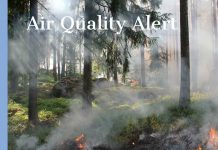
THUNDER BAY – Health – Pollution from forest fires impacts the health of people with asthma and other chronic obstructive lung diseases. Those are the findings of a new study in Biomed Central’s open access journal Environmental Health. This study uses data from pharmacies and dispensaries to measure the increase in drugs needed to alleviate symptoms associated with pollution.
In Ontario, at the official end of the 2012 forest fire season on October 31, there had been 1,611 wildfires recorded during 2012 affecting a total area of 151,181 hectares
Forest fires burn nearly 1000 km2 of trees in British Columbia every year. The Ministry of Environment keeps a close watch on levels of particulate matter in the air caused by these fires but it is harder to measure the impact of this pollution on the health of people unless they are admitted to hospital.
Research on Forest Fires in British Columbia
Researchers from British Columbia Centre for Disease Control and University of British Columbia used dispensary records to find out if forest fires caused an increase in use of short acting beta agonist (SABA) such as salbutamol. Salbutamol sulphate is typically used as an inhaler to relive symptoms of asthma, chronic obstructive pulmonary disease (COPD) and other obstructive lung diseases.
What they found was that pollution due to forest fires increased the need for salbutamol for up to 4 days after the fire – even a relatively small increase in smoke (10µg/m3 increase in PM2.5) was associated with a 6% increase in salbutamol dispensations.
In Ontario, operational spending for the 2012 fire season is estimated at approximately $159 million. This compares to approximately $229 million that was spent in 2011. Fire season spending is highly-variable and depends on seasonal activity. The impact on health is not calculated in most jurisdictions as a direct result of smoke and particulates from fires.
Dr Catherine Elliott, who led this study commented, “Our study shows that forest fires and pollution are impacting the health of people with chronic lung diseases. It also shows that it is possible to measure public health by monitoring dispensary databases, and that dispensary data shows effects in small populations, that have not been found in studies on other health measures such as visits to physicians’ offices. This information is often routinely collected, and available for the entire population, consequently it is possible to perform more meaningful analysis.”
Ontario Health: Forest Fire Smoke
The Ontario Ministry of Health states, “Forest fire smoke is made up of a mixture of gases and very small particles that are produced when wood and other organic matter burn. The small particles in forest fire smoke also occur with many other types of air pollution and have been linked to serious effects on people’s health. Smoke also contains toxic gases like carbon monoxide, that can also be harmful to your health”.

How can I protect myself and minimize the health effects of fire smoke?
- If smoke is affecting your breathing or making you uncomfortable in others ways, move to a less smoky area. Homes can get really hot with the windows closed. If you go indoors to get out of the smoke, be sure that the temperature indoors doesn’t create additional problems for you. Use air-conditioning if it is available and be sure to drink plenty of water to stay hydrated.
- If it is smoky outside, it is best not to go outdoors to do physical activity and a good time to stay indoors with the windows closed.
- If you have an HEPA air cleaner that will reduce levels of small particles in indoor air, use it and stay in the room where it is located.
- Use air conditioning in cars and keep windows closed. Remember, vehicles should never be run in an enclosed space like a garage.
- Avoid using smoke producing appliances such as wood stoves and even candles.
- Do not smoke tobacco inside – smoking puts added stress on your lungs and those around you.
- If you have asthma or other respiratory condition, be vigilant about avoiding smoke and taking your prescribed medicine. Speak with your health care provider to get the specific advice that is right for you.






